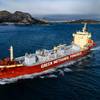Modern Technology’s Answer to the Ghost Ship
A Russian cruise ship, the Lyubov Orlova, allegedly adrift on the Atlantic Ocean since last year, is a haunting reminder of the present dangers that can afflict our shores. The 328-ft, 1,565-ton cruise liner was being towed down to the Dominican Republic to be sold for scrap metal from Canada when a storm caused the line to break, sending the floating catastrophe on an unplanned, perilous journey into the unknown waters.
The Lyubov Orlova, it is believed now by Western European authorities to have sunk to the bottom of the Atlantic, but earlier last week reports surfaced that this boat was on a crash course to the British Isles with cannibalistic, diseased rats on board. This spooky phenomenon is hardly the first account of a “Ghost Ship” being reported. Over history, there have been numerous reports of these abandoned and unmanned ships drifting hopelessly at sea, at times with disastrous endings. Perhaps the most famous of these being the Mary Celeste, which when found in 1872 was completely intact and under sail but devoid of all crew, a mystery still to this day.
After sending the Lyubov Orlova into international waters, Transport Canada said it was satisfied the ship “no longer poses a threat to the safety of [Canadian] offshore oil installations, their personnel, or the marine environment”.
In the last 10 years, technology companies have come up with innovative solutions to tackle some of the dangers associated with open water, such as piracy or risks of collision. One of them is the Spynel camera system, manufactured by HGH Infrared Systems; Spynel is a rotating, panoramic infrared thermal imaging camera that provides continuous monitoring of ultra-wide areas in real-time. Its high resolution image coupled with automatic detection and tracking of targets on 360 degrees ensures that no event is missed, even in total darkness or fog. In Maritime applications, Spynel can successfully operate on very rough seas thanks to an autonomous gyro-stabilized platform and come with sea-specific image processing algorithms. This built-in image processing allows for minimal false alarm rate and effective differentiation between distant small boats and waves. The Spynel systems are currently used by the French Navy for antipiracy purposes in the Gulf of Yemen.
Ghost ships and other collision risks in ports and open water can be intercepted effectively with the assistance of military grade equipment used today by private entities and security companies over the world.















